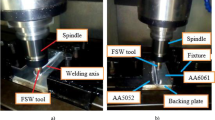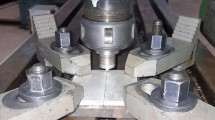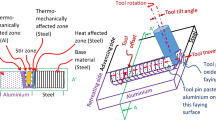Abstract
Aluminum 6xxx and 7xxx series are among the most commonly used alloys in industrial applications whereas their joining and welding using conventional fusion-based weld processes are very difficult. In this paper, friction stir welding process of dissimilar AA6061-T6 and AA-7277-T6 aluminum plates was investigated. The effects of tool travers and rotational speeds and the type of material located in the advanced side (AS) or retreating side (RS) of weldment were studied experimentally on the mechanical and metallurgical characteristics of the joint. Macro- and microstructure pictures of weld region were used to evaluate the quality of the weld and defect detections. Tensile strength tests and micro-hardness measurements of different areas in the weld section showed that the most strength and hardness values are achieved when the AA-7277-T6 was located in the AS of the weld. Accordingly, the highest tensile strength was about 78 % of the ultimate strengths of AA6061-T6 base metal which was obtained at the rotational and linear speeds of 825 rpm and 60 mm/min, respectively. Most of the tensile fractures were initiated from the heat-affected zone (HAZ) of AA6061-T6 alloy. The minimum hardness values were obtained from HAZ for both alloys, and the average hardness of joint was reduced by increasing the rotational speed. Also it was observed from the microstructure analyses that the size of grains in the HAZ area was greater than that of the nugget zone. Using artificial neural network (ANN) approach, the hardness and ultimate tensile strength of tested AA6061-T6 and AA-7277-T6 aluminum joint was predicted for different friction stir welding (FSW) process variables including the pin speeds and material position on AS and RS. Also, using a multi-objective optimization technique, a Pareto front (or Pareto optimal set) was obtained for both hardness and tensile strength results.
Similar content being viewed by others
References
Aydın H, Bayram A, Uğuz A, Akay KS (2009) Tensile properties of friction stir welded joints of 2024 aluminum alloys in different heat-treated-state. Mater Des 30(6):2211–2221
Bahemmat P, Haghpanahi M, Besharati MK, Ahsanizadeh S, Rezaei H (2010) Study on mechanical, micro-, and macrostructural characteristics of dissimilar friction stir welding of AA6061-T6 and AA7075-T6. Proc Inst Mech Eng B J Eng Manuf 224(12):1854–1864
Bozkurt Y, Bilici MK (2013) Application of Taguchi approach to optimize of FSSW parameters on joint properties of dissimilar AA2024-T3 and AA5754-H22 aluminium alloys. Mater Des 51:513–521
Cevik A, Kutuk MA, Erklig A, Guzelbey IH (2008) Neural network modeling of arc spot welding. J Mater Process Technol 202(1):137–144
Fotouhi Y, Rasaee S, Askari A, Bisadi H (2014) Effect of transverse speed of the tool on microstructure and mechanical properties in dissimilar butt friction stir welding of al5083–copper sheets. Eng Solid Mech 2(3):239–246
Guo JF, Chen HC, Sun CN, Bi G, Sun Z, Wei J (2014) Friction stir welding of dissimilar materials between AA6061 and AA7075 Al alloys effects of process parameters. Mater Des 56:185–192
Khodir SA, Shibayanagi T (2008) Friction stir welding of dissimilar AA2024 and AA7075 aluminum alloys. Mater Sci Eng B 148(1):82–87
Krishna P, Ramanaiah N, Roa K (2013) Optimization of process parameters for friction stir welding of dissimilar aluminum alloys (AA2024-T6 and AA6351-T6) by using Taguchi method. Int J Ind Eng Comput 4(1):71–80
Larsson H, Karlsson L, Stoltz S, Bergqvist EL (2000). Joining of dissimilar Al alloys by friction stir welding. In: Proceedings of the Second International Symposium on Friction Stir Welding, Gothenburg, Sweden, pp. 1–10
Lee, Y.M, Yeon, Jung S.B, in: KVJata, MWMahoney, RSMishra, SLSemiatin, T. Lienert (Eds.), Friction stir welding and processing II, TMS, Warrendale, PA, USA, 2003, p. 123
Li HY, Wei DD, Li YH, Wang XF (2012) Application of artificial neural network and constitutive equations to describe the hot compressive behavior of 28CrMnMoV steel. Mater Des 35:557–562
Li B, Zhang Z, Shen Y, Hu W, Luo L (2014) Dissimilar friction stir welding of Ti–6Al–4V alloy and aluminum alloy employing a modified butt joint configuration: influences of process variables on the weld interfaces and tensile properties. Mater Des 53:838–848
Mishra, R. S., & Mahoney, M. W. (Eds.). (2007) Friction stir welding and processing. ASM International, p.46
Moreira PMGP, Santos T, Tavares SMO, Richter-Trummer V, Vilaça P, de Castro PMST (2009) Mechanical and metallurgical characterization of friction stir welding joints of AA6061-T6 with AA6082-T6. Mater Des 30(1):180–187
Murali Krishna P, Ramanaiah N, Prasad Rao K (2013) Friction stir welds of AA6351-T6 and AA2024-T6 dissimilar aluminium alloys. J Manuf Sci Prod 13(1–2):7–13
Murr LE, Li Y, Flores RD, Trillo EA, McClure JC (1998) Intercalation vortices and related microstructural features in the friction-stir welding of dissimilar metals. Mater Res Innov 2(3):150–163
Ogura T, Nishida T, Tanaka Y, Nishida H, Yoshikawa S, Fujimoto M, Hirose A (2013) Microscale evaluation of mechanical properties of friction stir welded A6061 aluminium alloy/304 stainless steel dissimilar lap joint. Sci Technol Weld Join 18(2):108–113
Okuyucu H, Kurt A, Arcaklioglu E (2007) Artificial neural network application to the friction stir welding of aluminum plates. Mater Des 28(1):78–84
Pal S, Pal SK, Samantaray AK (2008) Artificial neural network modeling of weld joint strength prediction of a pulsed metal inert gas welding process using arc signals. J Mater Process Technol 202(1):464–474
Park JM, Kang HT (2007) Prediction of fatigue life for spot welds using back-propagation neural networks. Mater Des 28(10):2577–2584
Proton V, Alexis J, Andrieu E, Delfosse J, Lafont MC, Blanc C (2013) Characterisation and understanding of the corrosion behaviour of the nugget in a 2050 aluminium alloy friction stir welding joint. Corros Sci 73:130–142
Seidel TU, Reynolds AP (2003) Two-dimensional friction stir welding process model based on fluid mechanics. Sci Technol Weld Join 8(3):175–183
Shojaeefard MH, Behnagh RA, Akbari M, Givi MKB, Farhani F (2013) Modelling and Pareto optimization of mechanical properties of friction stir welded AA7075/AA5083 butt joints using neural network and particle swarm algorithm. Mater Des 44:190–198
Tan CW, Jiang ZG, Li LQ, Chen YB, Chen XY (2013) Microstructural evolution and mechanical properties of dissimilar Al-Cu joints produced by friction stir welding. Mater Des 51:466–473
Thomas WM (1991) Friction stir welding developments. TWI, Cambridge
Vilaça P, Quintino L, dos Santos JF (2005) i STIR—analytical thermal model for friction stir welding. J Mater Process Technol 169(3):452–465
Wan L, Huang Y, Lv Z, Lv S, Feng J (2014) Effect of self-support friction stir welding on microstructure and microhardness of 6082-T6 aluminum alloy joint. Mater Des 55:197–203
Author information
Authors and Affiliations
Corresponding author
Rights and permissions
About this article
Cite this article
Aliha, M.R.M., Shahheidari, M., Bisadi, M. et al. Mechanical and metallurgical properties of dissimilar AA6061-T6 and AA7277-T6 joint made by FSW technique. Int J Adv Manuf Technol 86, 2551–2565 (2016). https://doi.org/10.1007/s00170-016-8341-x
Received:
Accepted:
Published:
Issue Date:
DOI: https://doi.org/10.1007/s00170-016-8341-x




